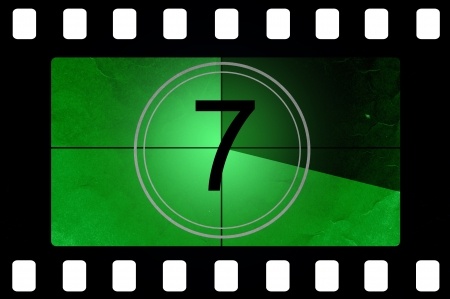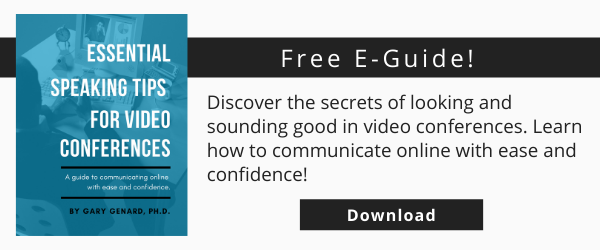
Want to know how to write a speech or build a presentation? Follow my 7-step method for speaking with influence!
You're experienced, knowledgeable, and passionate about your topic. Equally important, you're committed to giving listeners something that will help change their lives.
But do you know how to move an audience enough to make that happen? Whether you're speaking in person or virtually, how you relate to your audience is a key factor in your success.
It's a new world now! Do you speak with presence and poise in Zoom and other online meetings? Get my free guide, "Essential Speaking Tips for Video Conferences."
However much information you possess, it won't resonate with audiences unless they perceive you as a leader they can trust and follow. Better still, the more memorable you are as a speaker, the more people will be inspired by what you say and take the action you're looking for. So how do you consistently develop the influence that's so essential for communicating as a leader?

7 Steps to Building a Great Presentation Every Time
To start, learn how to craft presentations that consistently deliver excellence. Plenty of books and articles discuss developing dynamic presentation skills. And those skills are important. But if you want your message to resonate and move audiences to action, you need to understand what goes into building a successful talk.
This means combining a strategy to achieve impact with successful execution.
Ready to raise the bar on your performance? Get my Free e-book, High-Impact Speaking: The Leader's Guide to Presenting with Integrity and Influence."
Below are what I consider the 7 key components of creating effective presentations. Follow this road map, and you may become a speaker who spins straw into gold when you take the stage.
Step 1: Greeting. Speakers often neglect an audience greeting to their detriment. Your greeting is an essential element of your presentation for the following reasons: (1) It's your first and best opportunity to establish rapport with listeners; (2) Your audience is paying maximum attention at this point; (3) Your credibility and the audience's trust in you start here; (4) Your tone and "flavor" as a speaker are established now; and (5) You either demonstrate you're going to be interesting . . . or not.
Establish solid eye contact (don't keep looking down at those notes!). And know exactly what you're going to say so you get off to a strong start. Your conversation with listeners starts here.
Step 2: The Grabber. You must compel the audience's attention at the start of your actual speech. That means avoiding what I call the "Today, I'm Going to Talk About . . . ." approach. What could be more of a downer to an audience's excitement? Instead, blast off with something original, intriguing, and creative. Here are 12 foolproof ways to open a speech. Try one of these "grabbers," or come up with your own unique hook. Do this well and listeners will be engaged for everything that follows.
Step 3: Preview Your Speech. Once you've grabbed everyone's attention, clue them in on the specific aspects of the topic you're going to discuss. Ever listen to a speaker and still be wondering, five minutes into the talk, what the topic is? Audiences will be much more receptive if they know where you're going together. Following the great Dale Carnegie's advice: Tell 'em what you're going to say, say it, then tell 'em what you said. Here's my own acronym that might help: B-L-U-F, or Bottom Line Up Front.
Step 4. Main Points with Evidence. Develop your points logically backing up each one with evidence. Otherwise, it's all just your opinion. Why should listeners believe you over the next person? Evidence can take many forms: expert opinion, personal anecdote, statistic, story, client testimonial, report, experimental data, photographic evidence—the list is as long as what is credible and supportive for your talk. And don't forget transitions. You may know how your main points fit together, but your audience doesn't. I have more to say on transitions in Step 6, below.

Step 5: Vivid and Visual Language. If there's an orphan in the public speaking family, it's linguistics. Words can either denote (refer to explicitly) or connote (suggest an association). Of the two, connotations are much more evocative because they can be emotionally powerful. For instance, my New World Dictionary tells me that "female parent" is explicit and serviceable enough; but mother connotes love, caring, tenderness, and a world of positive associations. Use language that's vivid enough to bring emotional components front and center. Metaphors and comparative language are wonderful at doing this. And in terms of delivering that language, discover the Churchill Method of how to be an exciting speaker.
Step 6: Transitions. It's surprising how many speakers ignore transitions. They are always necessary to help audiences connect the main segments of a speech. How many times have you heard speakers say: "The next slide shows . . ."; "My next point is . . ."; and the infamous, "Moving right along . . ." The translation of each of these desperate pronouncements is: "I don't know how to get from what I was just talking about to the next main point, so I'll just baldly announce what's coming next." For your talks to be logical and whole, you must create effective transitions. For instance, an internal summary (which reminds people what you were just talking about) can be followed by an internal preview (concerning what's coming next). Transitions give your speeches a logical shape.
Step 7: The Clincher. Just as your opening needs a Grabber, you can go from mundane to memorable in your conclusion with a powerful clincher. Remember: your closing is an opportunity to make your speech resonate with listeners afterwards. So you need to do more than just recap your key points. Make the ending "sticky." Ask yourself: "What can I say that will help keep my message in everyone's mind?" Here's how to end vividly and memorably.
How to Practice a Video Conference Presentation
Today, there's another key area worth mentioning: how to practice for the ever-present video conferences. My advice here is, start hearing yourself talking about your topic as early as possible. The earlier you do this, in fact, the more likely you'll be on the right path to a presentation that sounds right in the ears of your audience. Here are more tips on how to improve your speaking skills in video conferences.
For instance, spend less time than you usually do writing, editing, and polishing your notes. Get in the speaking mode right away, because it's in the oral arena where you'll be strutting your stuff. The video conference platform is an intimate venue, so you need to sound like you're talking "heart to heart" about the things that matter.
At this point, practice by recording yourself on the screen. When you watch yourself, you'll see and hear exactly what everyone else will be experiencing. It wasn't possible to achieve this fidelity to the actual performance venue before, unless you had planned for a video meeting in the first place. But now your webcam performance is exactly how people will see you. Think of it as a silver lining in having to go virtual.
This article was originally published in 2013. It is updated here.
You should follow me on Twitter here.
Gary Genard is an actor, author, and expert in theater-based public speaking training. His company, Boston-based The Genard Method offers in-person and online training to help executives and teams become extraordinary communicators. In 2020 for the seventh consecutive year, Gary has been ranked by Global Gurus as One of The World's Top 30 Communication Professionals. He is the author of How to Give a Speech. His second book, Fearless Speaking, was recently named as "One of the 100 Best Confidence Books of All Time." Contact Gary here.



